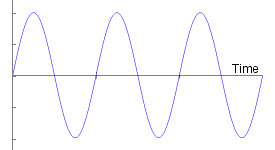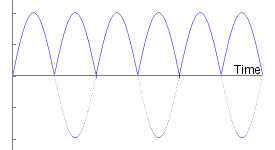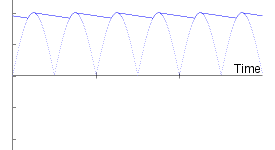Power supplies: Difference between revisions
| Line 6: | Line 6: | ||
==Why is a power supply needed?== | ==Why is a power supply needed?== | ||
A power supply performs some or all of the following purposes: | A power supply performs some or all of the following purposes: | ||
*'''Voltage conversion''': The mains electricity supply is 240v, which is much too high for most electronic gadgets and is dangerous if fingers might be exposed to it, so a voltage reduction may be required. In a few cases (e.g. a microwave oven or the supply to a camera flash tube), conversion to a higher voltage is required. | *'''Voltage conversion''': [[file:AC-graph.png|275px|thumb|right|AC waveform]]The mains electricity supply is 240v, which is much too high for most electronic gadgets and is dangerous if fingers might be exposed to it, so a voltage reduction may be required. In a few cases (e.g. a microwave oven or the supply to a camera flash tube), conversion to a higher voltage is required. | ||
*'''Isolation''': Even if the voltage is reduced, if there is still a direct electrical path to the mains it can still be dangerous. Professional power tools, especially if used outdoors, are often powered through an isolation transformer in order to break that path. | *'''Isolation''': Even if the voltage is reduced, if there is still a direct electrical path to the mains it can still be dangerous. Professional power tools, especially if used outdoors, are often powered through an isolation transformer in order to break that path. | ||
*'''Rectification''': The mains supply is AC, which means it reverses direction 100 times per second. Whilst this is fine for heating, some forms of lighting and most electric motors, electronics normally requires DC, which just goes in one direction. Rectification is the technical term for AC to DC conversion. | *'''Rectification''': [[file:rectified-AC-graph.png|275px|thumb|right|Recified AC]]The mains supply is AC, which means it reverses direction 100 times per second. Whilst this is fine for heating, some forms of lighting and most electric motors, electronics normally requires DC, which just goes in one direction. Rectification is the technical term for AC to DC conversion. | ||
*'''Smoothing''': AC momentarily drops to zero as it reverses direction, and if you simply rectify it, it will still be dropping to zero 100 times per second. This may be fine for example if you're just using it charge a battery, but electronic equipment generally can't cope with this. In audio equipment, for instance, it would cause a very loud buzz which would obliterate the music. Smoothing stores electrical energy to fill in the gaps and smooth the flow, a bit like the way the silencer on a car smooths the exhaust flow to make it quieter. | *'''Smoothing''': [[file:smoothed-AC-graph.png|275px|thumb|right|Rectified and smoothed AC]]AC momentarily drops to zero as it reverses direction, and if you simply rectify it, it will still be dropping to zero 100 times per second. This may be fine for example if you're just using it charge a battery, but electronic equipment generally can't cope with this. In audio equipment, for instance, it would cause a very loud buzz which would obliterate the music. Smoothing stores electrical energy to fill in the gaps and smooth the flow, a bit like the way the silencer on a car smooths the exhaust flow to make it quieter. | ||
*'''Regulation''': If the input mains voltage varies, the rectified and smoothed output will vary in proportion. Unless large and expensive smoothing components are used, there will remain a certain amount of "ripple" which can cause an annoying hum in audio equipment. If the power is supplied by a battery its voltage will drop as it is exhausted. Electronic equipment often needs a supply which is not only very smooth but a precise voltage. Regulation provides this. There are two kinds of voltage regulator: | *'''Regulation''': If the input mains voltage varies, the rectified and smoothed output will vary in proportion. Unless large and expensive smoothing components are used, there will remain a certain amount of "ripple" which can cause an annoying hum in audio equipment. If the power is supplied by a battery its voltage will drop as it is exhausted. Electronic equipment often needs a supply which is not only very smooth but a precise voltage. Regulation provides this. There are two kinds of voltage regulator: | ||
**In a '''linear regulator''', excess input power is simply absorbed and turned into heat, just a little if the excess is small or more if it's greater. This is a bit like putting a brick on the accelerator of your car and controlling your speed with the brake. It's wasteful but cheap, but nevertheless may be good enough for low power devices unless you need to squeeze the maximum life out of a battery. | **In a '''linear regulator''', excess input power is simply absorbed and turned into heat, just a little if the excess is small or more if it's greater. This is a bit like putting a brick on the accelerator of your car and controlling your speed with the brake. It's wasteful but cheap, but nevertheless may be good enough for low power devices unless you need to squeeze the maximum life out of a battery. | ||
**In a '''switching regulator''' the power is switched on and off very rapidly, with the on-time adjusted to compensate for variations | **In a '''switching regulator''' the power is switched on and off very rapidly, with the on-time adjusted to compensate for variations in the input. The output is then smoothed, but only small smoothing components are required as they only need to store energy to fill very brief gaps. This is like a room thermostat which is on for more of the time if it's very cold outside. The thermal inertia of the room smooths out the temperature variations as the thermostat switches on and off. A well designed switching regulator can be made very efficient, but is more complicated and more expensive that a linear regulator. | ||
A switching-mode power supply generally includes all of the above elements. The mains input is rectified and smoothed and then fed into a switching regulator. The switching regulator includes a transformer to provide isolation, but since the transformer is operating at the very high switching speed it can be much smaller than a mains transformer handling the same power, since it's transforming the power in much smaller bites. | A switching-mode power supply generally includes all of the above elements. The mains input is rectified and smoothed and then fed into a switching regulator. The switching regulator includes a transformer to provide isolation, but since the transformer is operating at the very high switching speed it can be much smaller than a mains transformer handling the same power, since it's transforming the power in much smaller bites. | ||
==Theory and operation of power supplies== | ==Theory and operation of power supplies== | ||
Revision as of 21:06, 3 August 2014
Power supplies: theory, diagnostics and fixing.
Summary
Many pieces of electronic equipment include a power supply unit (often abbreviated to PSU) to convert the incoming electrical power from the mains or a battery to the form needed. This can involve the control and conversion of a relatively large amount of power in a fairly small space and some of the power will be wasted as heat. Heat can lead to failures.
Why is a power supply needed?
A power supply performs some or all of the following purposes:
- Voltage conversion: The mains electricity supply is 240v, which is much too high for most electronic gadgets and is dangerous if fingers might be exposed to it, so a voltage reduction may be required. In a few cases (e.g. a microwave oven or the supply to a camera flash tube), conversion to a higher voltage is required.
- Isolation: Even if the voltage is reduced, if there is still a direct electrical path to the mains it can still be dangerous. Professional power tools, especially if used outdoors, are often powered through an isolation transformer in order to break that path.
- Rectification: The mains supply is AC, which means it reverses direction 100 times per second. Whilst this is fine for heating, some forms of lighting and most electric motors, electronics normally requires DC, which just goes in one direction. Rectification is the technical term for AC to DC conversion.
- Smoothing: AC momentarily drops to zero as it reverses direction, and if you simply rectify it, it will still be dropping to zero 100 times per second. This may be fine for example if you're just using it charge a battery, but electronic equipment generally can't cope with this. In audio equipment, for instance, it would cause a very loud buzz which would obliterate the music. Smoothing stores electrical energy to fill in the gaps and smooth the flow, a bit like the way the silencer on a car smooths the exhaust flow to make it quieter.
- Regulation: If the input mains voltage varies, the rectified and smoothed output will vary in proportion. Unless large and expensive smoothing components are used, there will remain a certain amount of "ripple" which can cause an annoying hum in audio equipment. If the power is supplied by a battery its voltage will drop as it is exhausted. Electronic equipment often needs a supply which is not only very smooth but a precise voltage. Regulation provides this. There are two kinds of voltage regulator:
- In a linear regulator, excess input power is simply absorbed and turned into heat, just a little if the excess is small or more if it's greater. This is a bit like putting a brick on the accelerator of your car and controlling your speed with the brake. It's wasteful but cheap, but nevertheless may be good enough for low power devices unless you need to squeeze the maximum life out of a battery.
- In a switching regulator the power is switched on and off very rapidly, with the on-time adjusted to compensate for variations in the input. The output is then smoothed, but only small smoothing components are required as they only need to store energy to fill very brief gaps. This is like a room thermostat which is on for more of the time if it's very cold outside. The thermal inertia of the room smooths out the temperature variations as the thermostat switches on and off. A well designed switching regulator can be made very efficient, but is more complicated and more expensive that a linear regulator.
A switching-mode power supply generally includes all of the above elements. The mains input is rectified and smoothed and then fed into a switching regulator. The switching regulator includes a transformer to provide isolation, but since the transformer is operating at the very high switching speed it can be much smaller than a mains transformer handling the same power, since it's transforming the power in much smaller bites.
Theory and operation of power supplies
Leaving this for Francis to do.
Safety
Mains driven power supplies can be dangerous to work on unless you fully understand what you're doing. They often contain large capacitors which can store dangerous voltages even after you've disconected the mains supply.
References
External links
- External links as bullet points


